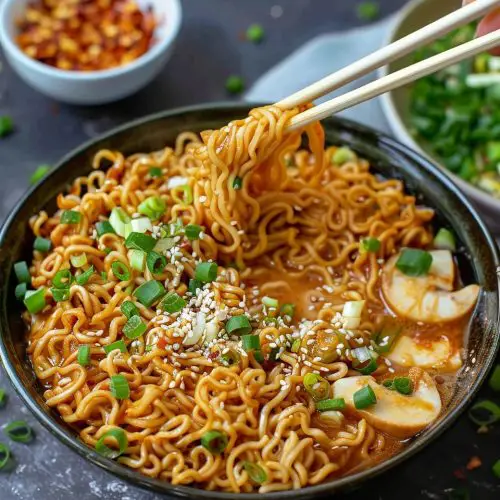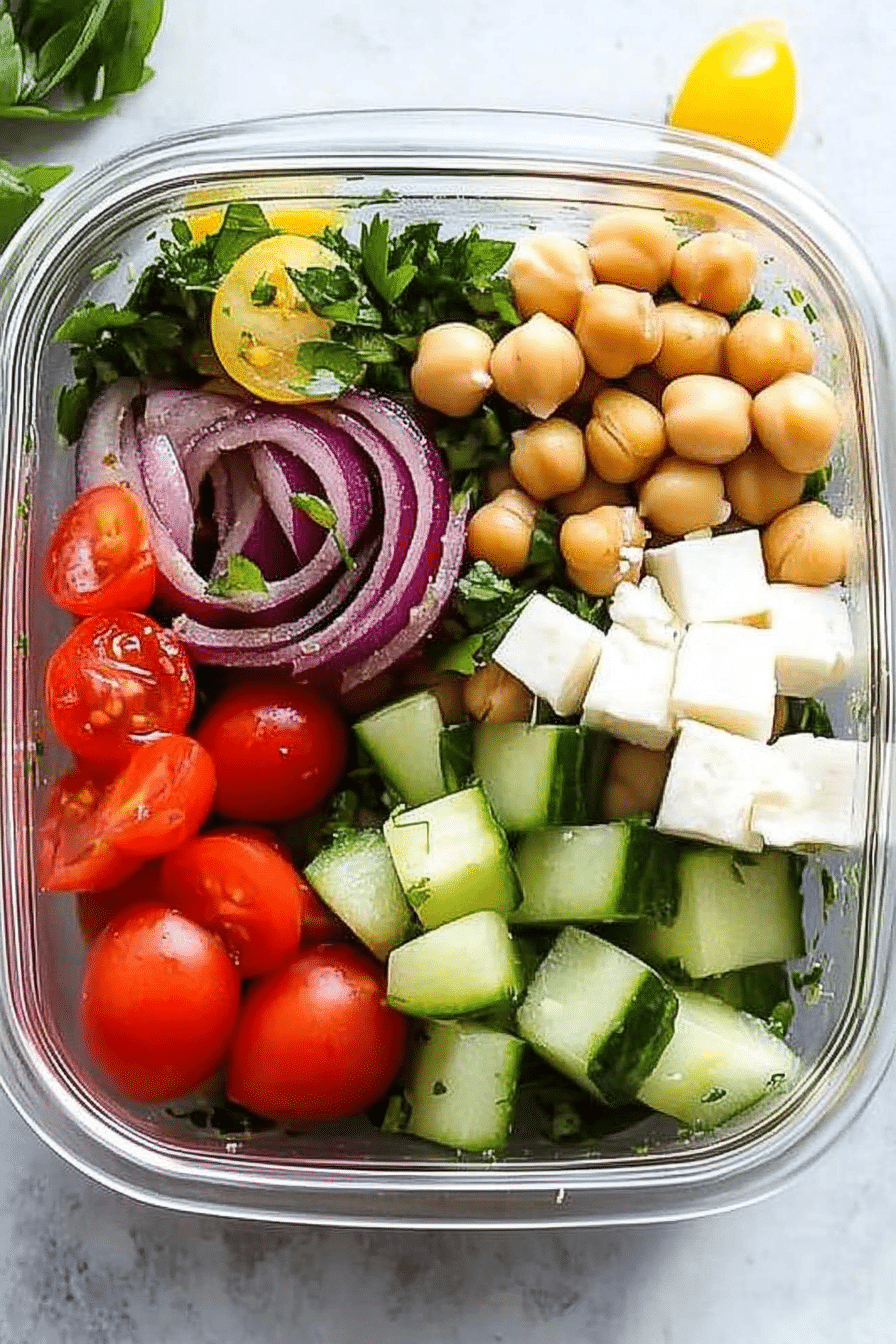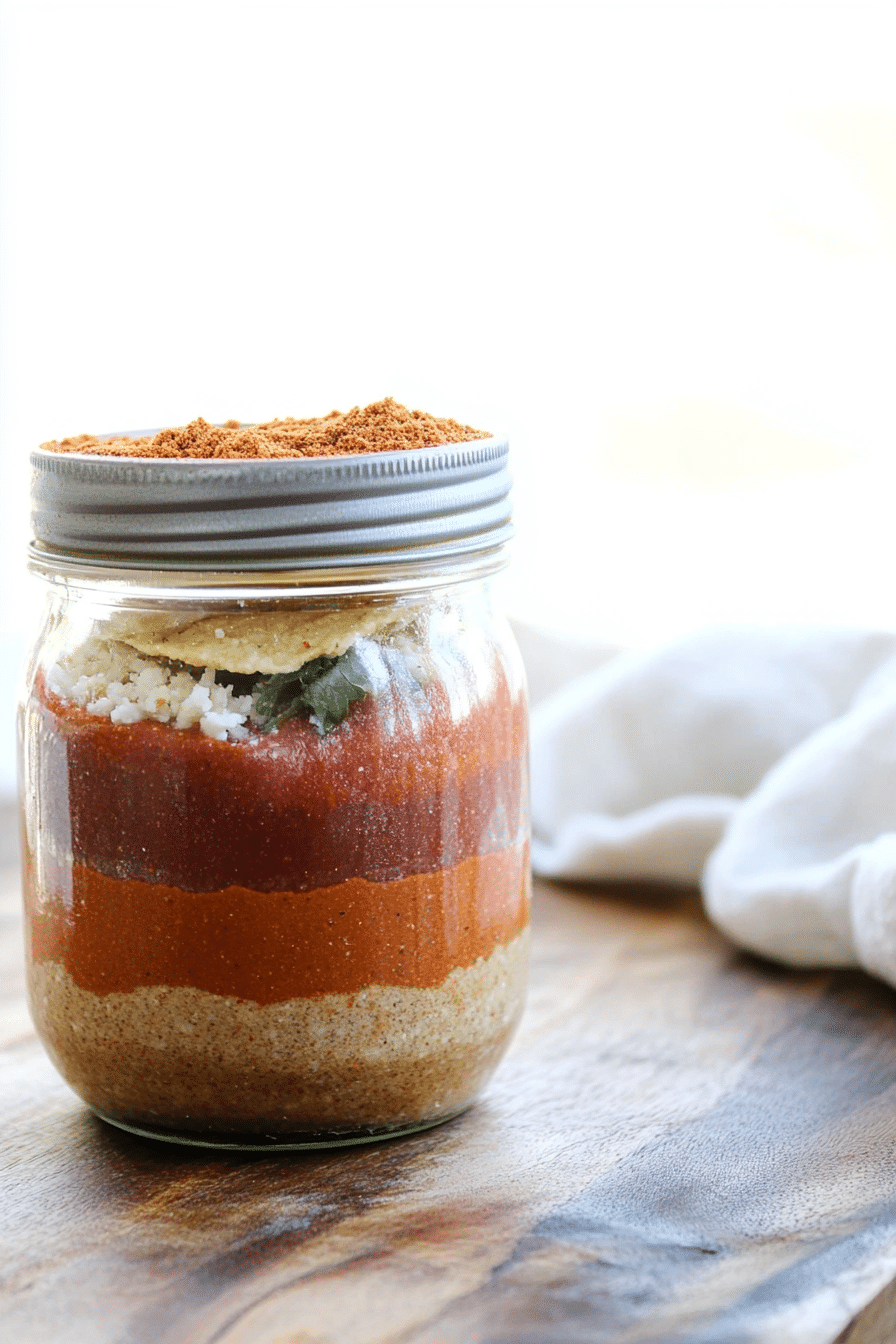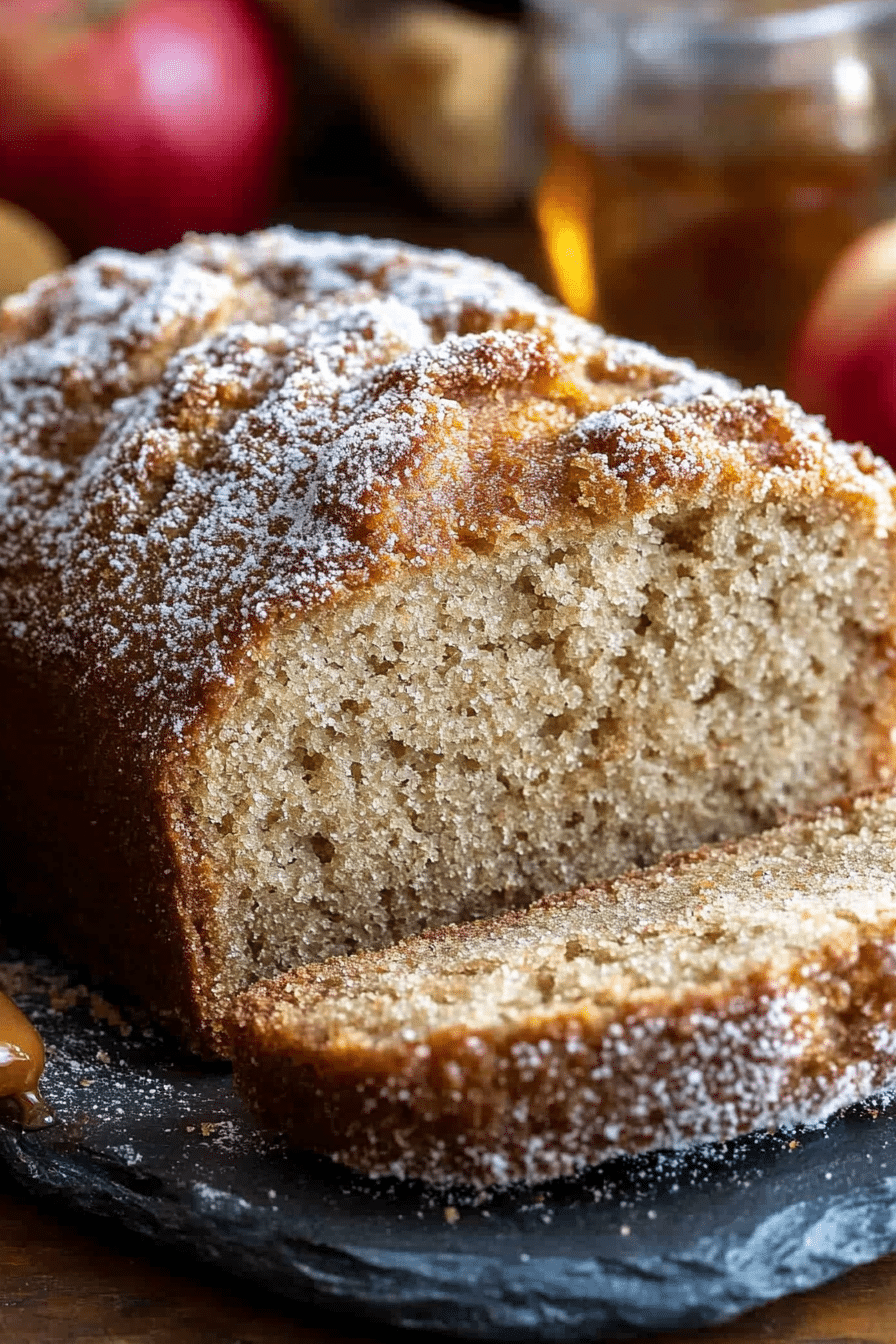I’m sipping coffee and thinking about the day I first fell for saucy ramen noodles—the moment the kitchen smelled like garlic and sesame, and the noodles glided into my bowl with that glossy, lacquered glaze. It felt fancy enough for a date night but simple enough to whip up after a long day. This isn’t a complicated project; it’s a weeknight favorite that somehow tastes like a hug in a bowl. I always tell friends it’s like your favorite pasta night, but with a gentler bite and a punch of Asian flavors that wake up your palate. The sauce clings to every strand, and the steam fogs up the windows in the coziest way. My kids actually beg for seconds, and that’s not a brag—it’s pure joy. The best part? You can adjust the heat, switch in mushrooms or spinach, and still end up with a perfect, saucy ramen noodles every single time. If you’re craving something comforting that also feels a little special, this is your recipe.
What is Saucy Ramen Noodles?
Saucy ramen noodles is basically the weekend glow-up for a humble pack of noodles. Think of it as ramen that’s dressed in a glossy, savory glaze—sticky, shiny, and deeply flavorful—so every bite feels indulgent without needing a long list of ingredients. The name says it all: you’re coating those ramen strands in a glaze that’s sweet, salty, a little tangy, and ever so slightly spicy depending on your mood. It’s essentially a one-pan, high-flavor routine: boil the noodles until they’re just al dente, whisk up a nimble sauce, sauté a few aromatics, and finish with a quick saucing that turns ordinary noodles into something you’ll crave again tomorrow. I love that this dish keeps the soul of ramen—slurp-able noodles and a comforting, homey scent—while giving you a glaze that feels like a done-in-one magic trick.
Why you’ll love this recipe?
What I love most about this saucy ramen noodles is how quickly it comes together without ever feeling rushed. It’s the kind of meal you can make on a busy weeknight and still have leftovers that taste as vibrant the next day. The flavor is layered—garlic, ginger, sesame, a kiss of soy, a touch of sweetness—so the sauce feels complex without being complicated. It’s also incredibly forgiving. You can switch in chicken, shrimp, or tofu, swap in kale or spinach, and still end up with the same glossy finish and bright, balanced notes. And it won’t wreck your grocery budget; pantry staples do most of the heavy lifting, which means you won’t be running to the store mid-week just to keep the sauce from sobbing in the pan. What I appreciate most is how this recipe adapts to mood: a little more heat if you’re hosting friends who like a spicy kick, or a milder version for kids who want a gentle, comforting bowl. This dish has become a lifesaver on busy nights, a reliable crowd-pleaser, and a dish my family asks for time and again.
- Flavor:A lacquered glaze that coats every noodle, combining salty soy, toasty sesame, garlic, and
- Simplicity:What is a streamlined, one-pan approach with quick sauces and fast sautéing—no long simmering or
- Cost-efficiency: Most ingredients are pantry staples, so you can turn a couple of dollars into a weeknight winner.
- Versatility: Swap proteins, mix in greens, or add toppings like a soft-boiled egg or kimchi for a new twist.
The scent alone is a memory trigger for me—garlic sizzle, sesame oils toasting, and the first pour of the glaze making the kitchen feel warm and inviting. This dish isn’t just dinner; it’s a little ritual that says, “You’re home.” If you’ve got a craving that’s somewhere between comfort food and something exciting, this is a great place to start. And a quick note: I’ve tested this with almond milk in a pinch, and you’ll be surprised how it softens the edge and still keeps the sauce glossy. Trust me on this one—sometimes little substitutions lead to a better texture.
How to Make Saucy Ramen Noodles
Quick Overview
In under 30 minutes, you’ll have a bowl that looks and tastes like you spent ages on it. Boil the noodles until just shy of al dente, whisk together a bright, salty-sweet glaze, and sauté aromatics that perfume the kitchen. Toss the noodles with the glaze, fold in your chosen fillings, and finish with a final drizzle or two of glaze for a shiny, restaurant-worthy lacquer. The beauty is in the balance: a little heat, a little tang, a lot of savor, and noodles that gulp every last drop of that sauce.
Ingredients
For the Main Batter:
- 8 oz ramen noodles (brick noodles or fresh), cooked to al dente and drained
- 3 tablespoons soy sauce, preferably low-sodium
- 2 tablespoons oyster sauce (or mushrooms sauce for a vegetarian version)
- 1 tablespoon brown sugar or honey
- 1 tablespoon rice vinegar
- 1 teaspoon sesame oil
- 1 teaspoon chili paste or 1/2 teaspoon chili oil, adjust to heat preference
- 1 clove garlic, minced
- 1 teaspoon grated fresh ginger
- 1 teaspoon cornstarch mixed with 2 teaspoons water (slurry)
For the Filling:
- Protein: 8 oz chicken thighs (thinly sliced), shrimp, or firm tofu, sliced
- Vegetables: 1 cup sliced mushrooms, 1 cup shredded cabbage or kale, 1 small carrot julienned
- Optional aromatics: 2 green onions, chopped; 1 tablespoon toasted sesame seeds
- Marinade for protein (optional): 1 tablespoon soy sauce, 1 teaspoon sesame oil, 1 clove garlic, minced
For the Glaze:
- 2 tablespoons soy sauce (additional)
- 1 tablespoon honey or maple syrup
- 1 teaspoon rice vinegar
- 1/2 teaspoon sesame oil
- Red Pepper flakes or a touch of chili oil to finish
- Sesame seeds and sliced scallions for garnish

Step-by-Step Instructions
Step 1: Preheat & Prep Pan
Grab a wide skillet or a sturdy wok and preheat it over medium-high heat. While it heats, have your noodles already cooked and drained. You’ll want the pan hot enough to give the aromatics a quick sizzle, but not so hot that the garlic burns. A fast, fragrant sauté is the difference between a bland spoonful and a memorable bite. Have your protein sliced and your vegetables ready to go, because this meal loves speed.
Step 2: Mix Dry Ingredients
In a small bowl, whisk together the dry components of the glaze: soy sauce, oyster sauce, brown sugar, and chili paste. The cornstarch slurry waits in reserve for a moment when you’re ready to glaze; you want it smooth and lump-free so the glaze coats the noodles evenly rather than clumping like a mistake you can’t rinse off. The slurry is your best friend for that glossy finish, so don’t skip it.
Step 3: Mix Wet Ingredients
In another bowl, stir the minced garlic and grated ginger with the sesame oil and rice vinegar. This quick, bright layer wakes up the sauce and keeps it from feeling flat. If you’re making this with kids, you can cut back on the chili and let the vinegar do most of the talking—no one wants a noisy tongue on a school night.
Step 4: Combine
Poor in your dry mix into the wet mixture gradually, whisking as you go. The sauce should loosen and thicken slightly as it warms; you’ll see a veil form over the spoon. If it’s too thick, splash in a tablespoon of water or broth until you reach a silky, pourable consistency. Now is the moment we fall in love with glaze: it’s glossy, cohesive, and ready to cling to every noodle.
Step 5: Prepare Filling
Season your protein with a light dash of soy and a whisper of sesame oil, then sear in a hot pan until just cooked through. Remove and set aside. In the same pan, toss the vegetables with a pinch of salt and a splash of the glaze to get a little sear on them. You want vegetables with a touch of bite, not mush, so keep the heat high enough to blister the edges quickly.
Step 6: Layer & Swirl
Return the protein to the pan, add the noodles, and pour the glaze over everything. Toss with a pair of tongs until every strand is coated and the sauce clings in a shiny coating. Here’s the fun part: you can swirl a little extra glaze in at this stage to create a marbled look—just a gentle turn and a couple of twists to distribute the color and shine. If you’re feeling fancy, top with green onions and sesame seeds for a stage-worthy finish.
Step 7: Bake
Optionally, you can slide the pan under a hot broiler for 1–2 minutes to caramelize the surface slightly and intensify the glaze. If you’re not into broiling, that’s totally fine—this dish shines on the stove and in the bowl. Bake or broil just enough to enhance the glaze’s sheen without drying out the noodles or scorching the aromatics.
Step 8: Cool & Glaze
Let the dish rest for a minute or two off the heat. A brief pause gives the sauce a chance to settle into the noodles, so when you dive in, you get that luscious, cohesive mouthful. If you like a terminal gloss, drizzle a tiny bit more of the glaze over the top and give the pan one final toss to distribute the shine. It’s all in the finish—your eyes want to see the glaze, your tongue wants to taste it.
Step 9: Slice & Serve
Dish into individual bowls, making sure each portion has a balanced mix of noodles, protein, and veggies. A sprinkle of scallions and sesame seeds looks gorgeous and adds a brightness that cuts through the richness. Serve with a side of pickled ginger or a runny-yolked egg if you’re feeling extra indulgent. The first slurp should deliver a soft crack of steam, followed by that satisfying, slightly chewy noodle texture and a glaze that lingers on the tongue. My family always says this sauce tastes best when it’s just warm enough to feel cozy but not so hot that it blinds you—perfect for late dinners or a comforting weekend lunch.
What to Serve It With
This dish is a superstar on its own, but a few well-chosen accompaniments can turn a simple weeknight into a small celebration.
For Breakfast: A light, savory bowl of saucy ramen noodles makes an ultra-satisfying morning. Top with a gently fried egg and a sprinkle of sesame seeds, and maybe add a few shreds of scallion for brightness. If you’re the type who loves a “ramen breakfast” vibe, keep the heat lower and let the glaze shine in a gentler way—it’s surprisingly comforting with a coffee snort and a quiet kitchen.
For Brunch: Plate it with a cucumber-sesame salad, a few pickled veggies, and a sparkling drink. A soft-boiled egg on top can elevate the dish to “brunch worthy,” and the extra richness from the yolk is the perfect cushion for the glaze’s savory edge.
As Dessert: Okay, dessert with saucy ramen isn’t typical, but hear me out: a tiny plate of grilled fruit (like pineapple or peach) brushed with a hint of the glaze and finished with a drop of lime makes a playful, palate-cleansing ending. It’s not a tradition, but it’s a cheeky nod to balance—sweet, tangy, and a little smoky. If you’d rather keep it strictly savory, end with a cooling scoop of sorbet or a crisp cucumber-caramelized ginger salad on the side.
For Cozy Snacks: Mini bowls for snacks between meals, topped with extra greens and a sprinkle of nori strips. It’s a fun, handheld option for movie nights or a casual gathering with friends.
We’ve turned this into a small family ritual: bowls lined up, the first bowl always gone within minutes, and a chorus of “More, please!” echoing around the table. The simple joy of dipping a spoon and hearing that soft clink against the ceramic is real. And yes, this is a dish I keep stocked in my mental rotation for its reliability and comfort factor. It just feels like a warm hug after a long day.
Top Tips for Perfecting Your Saucy Ramen Noodles
These little tips helped me dial in texture, flavor, and finish after countless tests in the kitchen with my friends and family:
Zucchini Prep: If you’re using zucchini or other watery veggies, squeeze out excess moisture after shredding or slicing. That moisture can thin your glaze and mute the glaze’s gloss. A quick salt-sweat and a gentle squeeze will keep the noodles from getting soggy and maintain that lacquered look.
Mixing Advice: Don’t overmix once the noodles hit the glaze. A light toss is enough to coat; overmixing can break down the noodles and make them mushy. If you’re worried about clumping, use a wide spatula and lift the noodles gently to distribute the sauce.
Swirl Customization: For a dramatic swirl, reserve a teaspoon of the glaze in a separate bowl and drizzle over the top in a quick circular motion. A quick pass with chopsticks or tongs can create those pretty marbling patterns that are as satisfying to look at as they are to eat.
Ingredient Swaps: I’ve swapped oyster sauce for mushroom sauce to keep it vegetarian, or used tamari for a soy-free option. Coconut aminos work in a pinch too, though they’ll change the flavor slightly. For heat lovers, double the chili paste or finish with a hot sesame oil drizzle at the end.
Baking Tips: If you do broil, keep a close eye—30 seconds can make the glaze look beautifully lacquered but 60 seconds can burn. The goal is a shiny surface, not a burnt edge. If you’re cooking for kids, skip the broiling step and rely on the stovetop technique for the glossy finish.
Glaze Variations: Add a teaspoon of mustard for a sharp tang, or a splash of rice wine for a slightly fruity note. A touch of smoked paprika can give the glaze a subtle smokiness that pairs nicely with mushrooms or charred veggies. Start small and taste as you go; the glaze should taste balanced before it hits the noodles.
My mistakes over the years taught me to trust the glaze. I once over-reduced it and ended up with a thick syrup that clung too aggressively to the noodles. Next time, I dialed back the sugar a touch and left a little more liquid for the final toss. The result was a glossy finish that wasn’t sticky or clumpy—just perfectly kissable with a nice bite of sesame seed crunch. It’s those tiny lessons that keep this recipe feeling fresh, even after you’ve made it a hundred times.
Storing and Reheating Tips
Leftovers happen in our house—sometimes because we cook too much, sometimes because we’re smart and cook once but eat twice. Here’s how I handle saucy ramen noodles so they stay tasty the second (and third) day.
Room Temperature: Not long. If you’ve got it sitting out, aim for no more than two hours. The sauce and noodles can separate, and nobody wants a lukewarm bowl that tastes like yesterday.
Refrigerator Storage: Store in a sealed container for up to 3 days. Keep the glaze on the side and toss at the last minute if you can; otherwise, the noodles will soak up more sauce and get softer over time.
Freezer Instructions: Freezing isn’t ideal for noodles because texture suffers after thawing. If you must, freeze the sauce separately in a freezer-safe container and cook fresh noodles when reheating, then toss everything together to re-create the glossy finish.
Glaze Timing Advice: If you’re reheating, warm the sauce separately and mix in after you reheat the noodles. That helps you maintain that bright lacquer rather than a dull, gummy coating. A quick splash of water or broth can revive things if they seem dry.
[Note: This approach keeps your noodles feeling fresh and saucy without the dreaded “reheated cardboard” effect.]
Frequently Asked Questions
Final Thoughts
This saucy ramen noodles recipe has become a bright thread in the fabric of my week. It’s not about perfection; it’s about balance, comfort, and the little surprises you discover while cooking—like how a touch of almond milk can soften the glaze without losing that lacquered shine, or how a handful of greens adds a pop of color that makes the whole bowl feel alive. It’s the dish I turn to when I want something familiar but a little adventurous, a meal that invites conversation and a shared smile across the table. If you try it and tweak it to your liking, please tell me what you changed. I love hearing about your substitutions, your favorite toppings, and the ways your family reacts to that first glorious slurp. Happy cooking, and I can’t wait to hear how yours turns out!

Saucy Ramen Noodles
Ingredients
Main Ingredients
- 2 packages instant ramen noodles
- 0.5 cup soy sauce
- 2 tablespoons sesame oil
- 1 tablespoon rice vinegar
- 1 teaspoon sugar
- 0.5 teaspoon red pepper flakes optional, adjust to taste
- 2 cloves garlic minced
- 1 inch ginger grated
- 2 cups vegetable broth
- 0.5 cup scallions chopped, for garnish
- 0.5 cup sesame seeds toasted, for garnish
Instructions
Preparation Steps
- Cook ramen noodles according to package directions. Drain and set aside.
- In a small bowl, whisk together soy sauce, sesame oil, rice vinegar, sugar, red pepper flakes (if using), minced garlic, and grated ginger.
- In a medium saucepan, heat the vegetable broth over medium heat. Bring to a simmer.
- Add the cooked ramen noodles and the sauce mixture to the saucepan with the broth. Stir well to coat the noodles evenly.
- Cook for 2-3 minutes, or until the sauce has thickened slightly and the noodles are heated through. Stir frequently.
- Serve immediately, garnished with chopped scallions and toasted sesame seeds.
Notes
Featured Comments
“Impressed! Clear steps and so flavorful results. Perfect for busy nights.”
“New favorite here — perfect for busy nights. crowd-pleaser was spot on.”
“Super easy and turned out amazing! My family asked for seconds. Saving this one.”
“This sweet treat was absolutely loved — the rich really stands out. Thanks!”
“Made it tonight and wow — creamy! Will definitely make saucy ramen noodles again.”
“Packed with flavor and so simple. Exactly what I wanted from saucy ramen noodles.”












